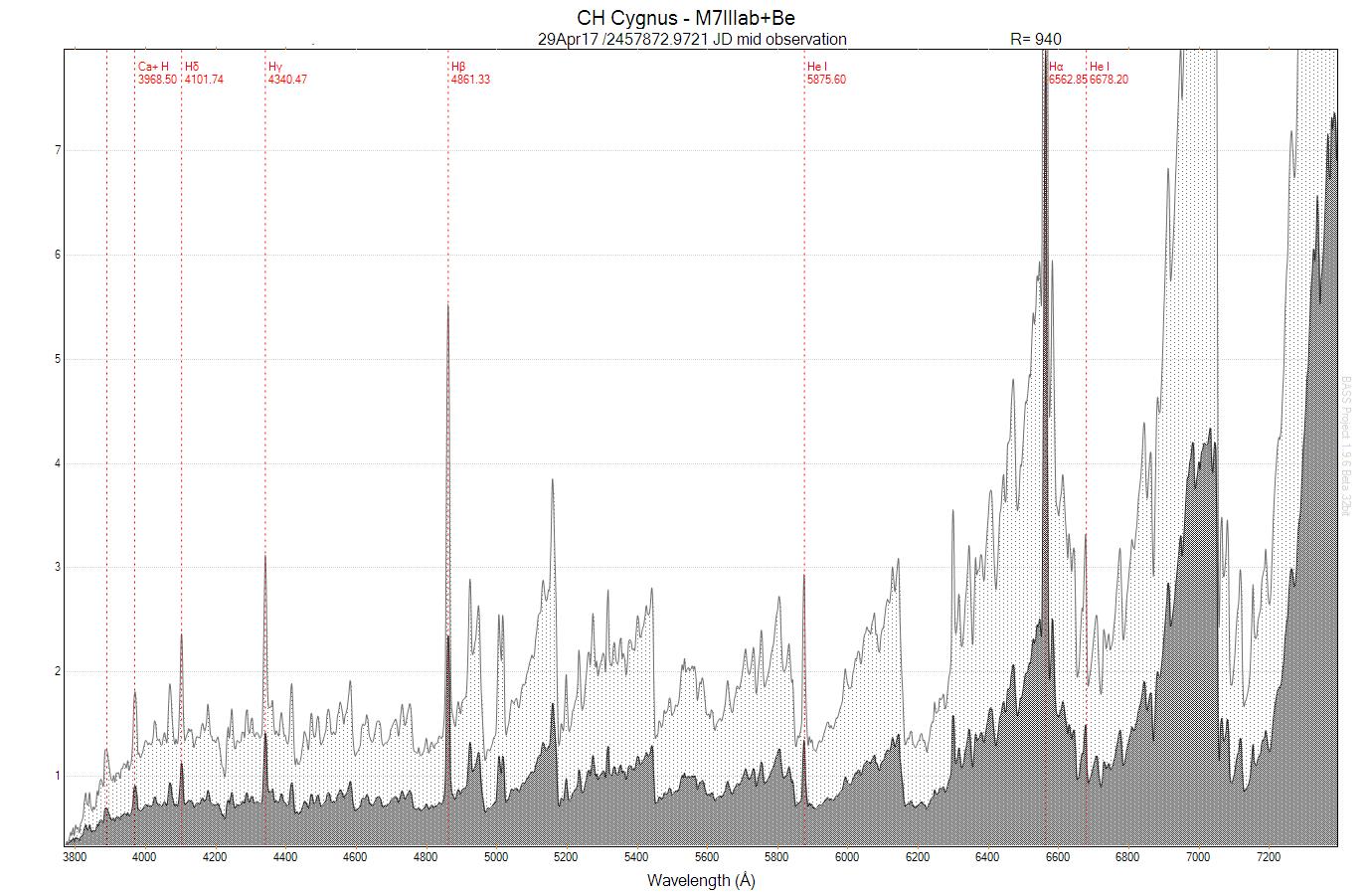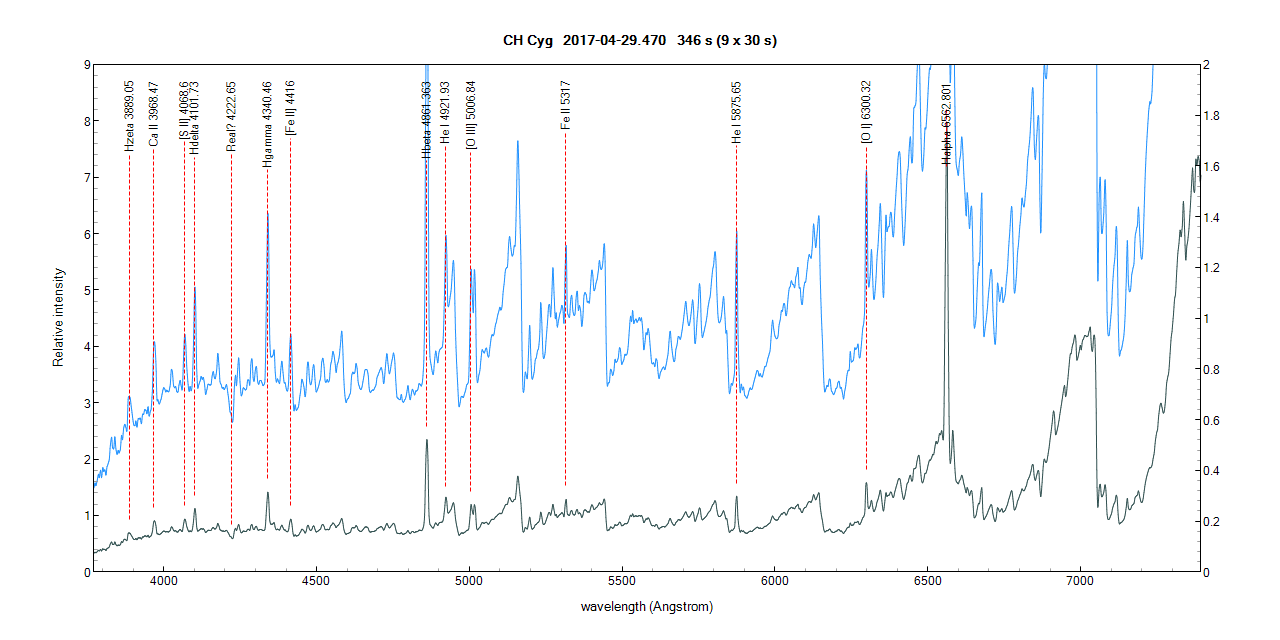CH Cygni
-
Joan Guarro Flo
- Posts: 714
- Joined: Thu Nov 03, 2011 8:50 pm
Re: CH Cygni
Hi,
Is the CH Cyg on the last njght.
Cheers, Joan.
Is the CH Cyg on the last njght.
Cheers, Joan.
- Attachments
-
- _chcyg_20170410_087_J. GUARRO.png (6.61 KiB) Viewed 11127 times
-
- _chcyg com1.png (6.21 KiB) Viewed 11127 times
-
- _chcyg com2.png (10.99 KiB) Viewed 11127 times
-
Francisco Campos
- Posts: 88
- Joined: Sun Nov 29, 2015 10:13 pm
Re: CH Cygni
Excel.lent, Joan, as always...
Here is a comparison of two low resolution spectra of CH Cyg. The first one, taken in July 2016; and the last one, only two nights ago. The difference is amazing... Both spectra taken with the DADOS (R=800) and the newton 8".
Both spectra taken with the DADOS (R=800) and the newton 8".
Also, I upload the photometric curve taken from the AAVSO database. I expected that CH Cyg would be brighter, but not. The only important difference I see is that the star seems brighter in the Johnson-B band, but in Johnson-V band the star has weakened. Maybe the red component has faded and, on the other hand, the hot component and the surrounding nebula are more excited?
Greetings
Fran
Here is a comparison of two low resolution spectra of CH Cyg. The first one, taken in July 2016; and the last one, only two nights ago. The difference is amazing...
Also, I upload the photometric curve taken from the AAVSO database. I expected that CH Cyg would be brighter, but not. The only important difference I see is that the star seems brighter in the Johnson-B band, but in Johnson-V band the star has weakened. Maybe the red component has faded and, on the other hand, the hot component and the surrounding nebula are more excited?
Greetings
Fran
-
Francois Teyssier
- Posts: 1565
- Joined: Fri Sep 23, 2011 1:01 pm
- Location: Rouen
- Contact:
CH Cygni Commented Spectrum
A full (almost!) commented spectrum of CH Cygni, with more than 100 identified lines (from various published values)
with PlotSpectra (Tim Lester)
Examples: Range 4800-5000 and 6000-7200
Note [SII] doublet
Other Ranges: http://www.astronomie-amateur.fr/feuill ... html#Lines
François
with PlotSpectra (Tim Lester)
Examples: Range 4800-5000 and 6000-7200
Note [SII] doublet
Other Ranges: http://www.astronomie-amateur.fr/feuill ... html#Lines
François
François Teyssier
http://www.astronomie-amateur.fr
http://www.astronomie-amateur.fr
-
James Foster
- Posts: 456
- Joined: Sun Jan 24, 2016 7:14 am
Re: CH Cygni
Here is a belated CH Cyg spectrum I took with my LISA spectroscope with the CDK17 F/6.8 reflector working at F/6.8 on 29Apr17:

Very strong H-Alpha emission is seen (almost 8x the intensity of the continuum from 3800-7400A) and at least two He lines showing at 5875.6 and 6678.2 angstroms respectively.
James

Very strong H-Alpha emission is seen (almost 8x the intensity of the continuum from 3800-7400A) and at least two He lines showing at 5875.6 and 6678.2 angstroms respectively.
James
James Foster
eShel2-Zwo ASI2600MM Pro
Lhires III (2400/1800/600 ln/mm Grat) Spectroscope
LISA IR/Visual Spectroscope (IR Configured)
Alpy 200/600 with Guide/Calibration modules and Photometric slit
Star Analyzer 200
eShel2-Zwo ASI2600MM Pro
Lhires III (2400/1800/600 ln/mm Grat) Spectroscope
LISA IR/Visual Spectroscope (IR Configured)
Alpy 200/600 with Guide/Calibration modules and Photometric slit
Star Analyzer 200
-
Francois Teyssier
- Posts: 1565
- Joined: Fri Sep 23, 2011 1:01 pm
- Location: Rouen
- Contact:
Re: CH Cygni
That's good, James!
You can look at [O III] and [O I]
François
You can look at [O III] and [O I]
François
François Teyssier
http://www.astronomie-amateur.fr
http://www.astronomie-amateur.fr
-
James Foster
- Posts: 456
- Joined: Sun Jan 24, 2016 7:14 am
Re: CH Cygni
To: François,
RE:"You can look at [O III] and [O I]"
I re-plotted the 29Apr17 spectrum for CH Cyg using Tim Lester's PlotSpectra 1.4.1.0:

Its hard to find the OIII and OI line IDs in Bass 1.96, so I use Plotspectra for these.
Are the SII(4068.6A), FeII(5317A), FeII(4416A), HeI(4921.93), HeI(5875.65A), and HeI(6678.15A) lines also good?
I wonder if that "absorption" feature around 4222.65A is real?
James
RE:"You can look at [O III] and [O I]"
I re-plotted the 29Apr17 spectrum for CH Cyg using Tim Lester's PlotSpectra 1.4.1.0:

Its hard to find the OIII and OI line IDs in Bass 1.96, so I use Plotspectra for these.
Are the SII(4068.6A), FeII(5317A), FeII(4416A), HeI(4921.93), HeI(5875.65A), and HeI(6678.15A) lines also good?
I wonder if that "absorption" feature around 4222.65A is real?
James
James Foster
eShel2-Zwo ASI2600MM Pro
Lhires III (2400/1800/600 ln/mm Grat) Spectroscope
LISA IR/Visual Spectroscope (IR Configured)
Alpy 200/600 with Guide/Calibration modules and Photometric slit
Star Analyzer 200
eShel2-Zwo ASI2600MM Pro
Lhires III (2400/1800/600 ln/mm Grat) Spectroscope
LISA IR/Visual Spectroscope (IR Configured)
Alpy 200/600 with Guide/Calibration modules and Photometric slit
Star Analyzer 200
-
Ken Harrison
- Posts: 197
- Joined: Thu Oct 25, 2012 5:45 am
- Location: St Leonards, Australia
- Contact:
Re: CH Cygni
James,
The latest V1.9.7 release of BASS Project has enhanced labelling and extended element listing.....
A significant absorption at 4226.73A is shown in Walker's atlas as a Ca I feature.......
The latest V1.9.7 release of BASS Project has enhanced labelling and extended element listing.....
A significant absorption at 4226.73A is shown in Walker's atlas as a Ca I feature.......
"Astronomical Spectroscopy - The Final Frontier" - to boldly go where few amateurs have gone before....
"Imaging Sunlight - Using a digital Spectroheliograph" - Springer
http://www.astronomicalspectroscopy.com
"Imaging Sunlight - Using a digital Spectroheliograph" - Springer
http://www.astronomicalspectroscopy.com
-
Francois Teyssier
- Posts: 1565
- Joined: Fri Sep 23, 2011 1:01 pm
- Location: Rouen
- Contact:
Re: CH Cygni
Hello James,
Ca II 3969 should be replaced by H epsilon 3970
If you have Balmer lines in emission, *all* the lines must appear
[S II] is a possible identification
You can check with Joan's spectra.
If it is [S II], this is a doublet and at higher resolution, the two lines (4068 and 4076)must appear
Ca I 4226 can be strong enough in a ~ K4III constinuum to appear at that resolution
He I lines are correct
About Fe lines, it is difficult at that resolution to be sure. Some features of the TiO band can mimic a line.
I suggest you get a M5III Spectrum and then compare CH Cyg and the reference M5III pseudo-continuum. The *real* emission will clearly appear (or not).
All the best,
François
.
Ca II 3969 should be replaced by H epsilon 3970
If you have Balmer lines in emission, *all* the lines must appear
[S II] is a possible identification
You can check with Joan's spectra.
If it is [S II], this is a doublet and at higher resolution, the two lines (4068 and 4076)must appear
Ca I 4226 can be strong enough in a ~ K4III constinuum to appear at that resolution
He I lines are correct
About Fe lines, it is difficult at that resolution to be sure. Some features of the TiO band can mimic a line.
I suggest you get a M5III Spectrum and then compare CH Cyg and the reference M5III pseudo-continuum. The *real* emission will clearly appear (or not).
All the best,
François
.
François Teyssier
http://www.astronomie-amateur.fr
http://www.astronomie-amateur.fr
-
Francois Teyssier
- Posts: 1565
- Joined: Fri Sep 23, 2011 1:01 pm
- Location: Rouen
- Contact:
Re: CH Cygni
From observations in August, both at low (Woody Sims and James Foster) and high resolution (Joan Guarro, Tim Lester, François Teyssier), strong absorptions in H beta and lower Balmer lines appear clearly with max velocities from -2000 to -3000 km/s (and perhaps more)
H beta profile from echelle spectra François
H beta profile from echelle spectra François
François Teyssier
http://www.astronomie-amateur.fr
http://www.astronomie-amateur.fr
-
Christian Buil
- Posts: 1432
- Joined: Mon Sep 26, 2011 6:59 pm
- Contact:
Re: CH Cygni
Spectrum of CH Cygni taken the 12.8/09/2017 at R = 49 000 (VHIRES-MO spectrograph):

Christian

Christian